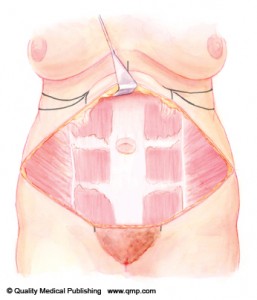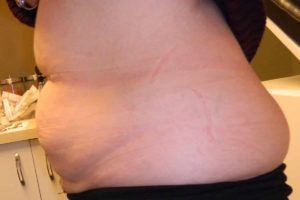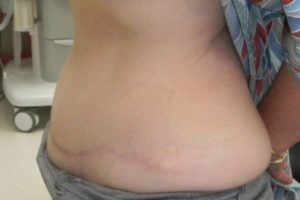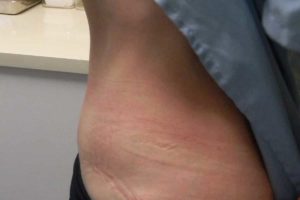
The majority of patients seeking tummy tuck surgery (abdominoplasty) are healthy and physically active but nonetheless they have excess skin and fatty tissue on the lower abdomen. This is a particularly common problem for females after childbirth or for those who have lost a significant amount of weight. Tummy tuck surgery is best performed on people who have a healthy weight or are only modestly overweight. It is not recommended as a weight loss procedure for very overweight patients due to the increased risk of complications.
During your consultation, Dr. Andrade will ask about your specific abdominal concerns, including any past abdominal surgery. The physical examination is very important and will include examining your abdomen for overall skin quality and the amount of excess adipose tissue, location of pre-existing scars, hernias and loose abdominal muscles. Photos will be taken so the preoperative and postoperative appearance can be compared.
Patients seeking abdominoplasty surgery can choose between a “mini tummy tuck” or a full tummy tuck. A typical mini tummy tuck involves removing loose skin from the lower part of the abdomen. It is commonly performed in combination with focal liposuction contouring of the abdomen around the belly button area. The most common type of patient seeking this type of operation is a woman who has finished having children, and despite having returned to her normal body weight, still has loose lower abdominal skin. Advantages of a mini tummy tuck include quicker recovery time, a shorter scar and decreased cost. However, it is only recommended for patients who are mainly concerned about the appearance of their lower abdomen. Some improvement in the appearance of the upper abdomen or flanks can be achieved with liposuction done at the same time.

A full tummy tuck is a more involved operation. The excess skin and adipose tissue on the upper and lower abdomen is removed, and usually the underlying rectus muscles are tightened. Both of these steps help flatten the abdomen and improve its contour. Dr. Andrade does a “drainless tummy tuck” in most cases. Advantages of a full tummy tuck include the ability to improve the appearance of the entire abdomen. However, the operation and recovery time are longer than a mini tummy tuck. During your consultation, Dr. Andrade will provide advice which operation is appropriate, depending on your physical characteristics and desired result. Dr. Andrade’s tummy tuck operation includes multiple steps that are not performed by all surgeons, but in his opinion lead to a superior result:
Abdominoplasty surgery is performed either at Dr. Andrade’s facility or at Southlake Regional Health Centre, and is done on either an inpatient or outpatient basis:
Most patients are up walking within several hours after surgery, leaning forward slightly to take tension off the abdomen and the incision. The following day patients may perform their own activities of daily living as tolerated. Most patients are candidates for a “drainless tummy tuck” but if wound drains are inserted, they are often removed within 3-5 days after surgery. Wound drainage can remain elevated in some patients for a longer period, especially if they are too active following the operation. A stretchy compression garment called a “binder” is worn on the abdomen for 3 weeks, to decrease fluid accumulation and swelling. Heavy lifting or vigorous exercise involving the abdominal muscles for should be avoided for 4-6 weeks following surgery. A scar reduction program will be recommended by Dr. Andrade.
The majority of patients are very satisfied with the appearance of their abdomen following tummy tuck surgery. While good results are usually achieved and complications are uncommon, it is important to understand the risks associated with surgery. Potential problems in the immediate postoperative period include but are not limited to bleeding that requires a blood transfusion, fluid collections requiring drainage (seroma), infection, wound healing problems, and loss (necrosis) of the abdominal skin. Long-term problems include chronic pain or numbness, contour irregularities or prominent scars. Rarely, life-threatening complications can arise during or after any operation. Dr. Andrade will discuss your specific risks and answer all of your questions during the consultation.
This information is intended to complement the advice of a plastic surgeon obtained during a proper consultation, and it is by no means exhaustive or complete.
Tummy tuck surgery is not an OHIP-covered procedure. Removal of loose skin on the the body is not covered by provincial insurance regardless of the cause (even after massive weight loss or previous surgery for obesity). Another abdominal procedure called “panniculectomy” may be an OHIP-insured procedure in certain patients who have a very large overhang of skin (called a “pannus”) on the lower abdomen. In order to qualify for surgery, the patient must have evidence that the pannus causes serious problems like recurrent infections requiring prescription antibiotics. Panniculectomy surgery is not the same as tummy tuck surgery because it does not involve tightening the abdominal muscles or improve the appearance of the upper abdomen. It simply involves removing the overhang of skin.
Ideally it is best to be at a steady weight prior to having abdominoplasty surgery. This ensures that the maximal amount of skin can be removed. If there is significant weight loss after surgery there can be some recurrent skin laxity, depending on each patient’s skin tone. Some patients will still have an excellent contour. This patient had a tummy tuck and was very happy with the appearance, but she was motivated to lose another 30 pounds postoperatively. After this additional weight loss the abdominal contour was further improved. The photos below show her appearance at each stage.

Before

After Surgery

After Surgery + Weightloss
The outcome of tummy tuck surgery depends on each person’s existing anatomy, not just the procedure itself. The operation only removes excess skin and fatty tissue which is superficial to the muscles. Any abdominal bulging due to tissue deep within the body (organs or intraperitoneal fat) will not be correct. Patients who have lost weight and have loose, hanging skin and fat will typically see the most dramatic contour improvement. In contrast, those patients who have a tight, protruding, barrel-shaped abdomen will not have correction of the bulging contour. It is important to find before-and-after photos of people with a similar body shape as yours, to determine if you might be satisfied with the degree of improvement than can be realistically achieved.
“Hourglass abdominoplasty surgery” has the potential to substantially improve the overall abdominal contour, including the waistline. However, the operation does not change the bony structure, (like the shape of the ribs and pelvic bones) and it does not alter the muscles lateral to the abdomen. Patients who have pre-existing waist curvature will typically see this contour improved. Conversely, those patients who have a straight, trunk-like waistline before surgery likely will not achieve an hourglass waistline afterward. Dr. Andrade always does a thorough in-person consultation to assess each person’s unique anatomy (never delegating this important role to someone else), then he discusses the anticipated improvement that may be achieved.
Liposuction is an important addition to tummy tuck surgery, but it is not always desired or needed. This procedure enables the surgeon to target focal bulges (for example, on the upper abdomen and flanks) that might not be addressed by tummy tuck surgery alone. The degree of additional improvement is typically modest, perhaps removing 30-40% of the fat in a given area. The additional contour gains must be weight against the additional risks and costs of the procedure. Dr. Andrade does not automatically recommend liposuction for each patient, but rather he makes individualized recommendations based on each patient’s anatomy, goals and expectations.
Our website contains before and after photos of Dr. Andrade’s patients with their treated anatomy exposed. These photos are intended to help our patients make an informed decision about surgery, and they are not testimonials or endorsements. Each person is unique therefore we cannot guarantee that you will achieve the same results. A thorough in-person consultation is necessary to understand your options and possible outcomes. By proceeding, you acknowledge that you are over 18 years of age.